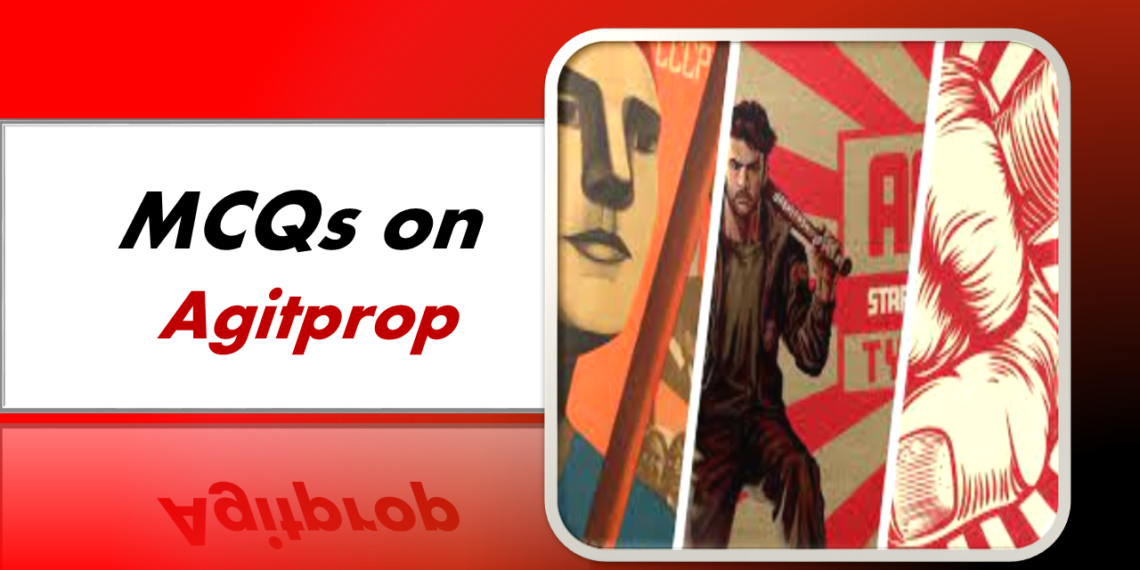MCQs on Agitprop
1. What does the term “Agitprop” stand for?
a) Aggressive Proposition
b) Agitating Proprietorship
c) Agitation-Propaganda
d) Agricultural Property
2. Agitprop is a form of:
a) Political satire
b) Political activism
c) Literary criticism
d) Scientific research
3. The term “Agitprop” originated in which country?
a) Germany
b) France
c) Russia
d) China
4. Agitprop is often associated with which political ideology?
a) Fascism
b) Communism
c) Capitalism
d) Conservatism
5. In the context of Agitprop, what does “agitation” refer to?
a) Calm and reasoned discussion
b) Intense emotional appeal
c) Scientific analysis
d) Political compromise
6. Which historical period saw the rise of Agitprop as a prominent form of political communication?
a) The Renaissance
b) The Enlightenment
c) The Industrial Revolution
d) The early 20th century
7. Agitprop is closely associated with the promotion of:
a) Religious freedom
b) Workers’ rights
c) Monarchy
d) Censorship
8. The term “Agitprop” was first used by which political party in Russia?
a) Bolsheviks
b) Mensheviks
c) Socialist Revolutionary Party
d) Kadets
9. Agitprop utilizes various artistic forms, including:
a) Poetry and literature
b) Music and danceMCQs on Agitprop
c) Visual arts and posters
d) All of the above
10. Which Russian leader was known for utilizing Agitprop extensively for political purposes?
a) Joseph Stalin
b) Vladimir Lenin
c) Mikhail Gorbachev
d) Boris YeltsinMCQs on Agitprop
11. Agitprop is designed to:
a) Promote critical thinking
b) Maintain the status quo
c) Inform and educateMCQs on Agitprop
d) Mobilize and influence public opinion
Also Read-
50+ MCQs on the Southern Agrarians
12. Which term is often used interchangeably with Agitprop?
a) Satire
b) Propaganda
c) Enlightenment
d) Censorship
13. What role does emotion play in Agitprop?
a) Minimal, as it relies on factual information
b) Moderate, as it aims for a balanced approach
c) Significant, as it relies on emotional appeal
d) None, as it prioritizes logic and reason
14. Agitprop is commonly associated with which form of government?
a) Oligarchy
b) Totalitarianism
c) Democracy
d) Anarchy
15. Which art form is often used to convey Agitprop messages to a mass audience?
a) Classical music
b) Abstract painting
c) Folk music and songs
d) Ballet
16. Agitprop posters are known for their use of:
a) Neutral colors
b) Subtle imageryMCQs on Agitprop
c) Bold colors and striking imagery
d) Abstract patterns
17. The term “Agitprop” became prominent during the:
a) 19th century
b) 18th century
c) 20th centuryMCQs on Agitprop
d) 17th century
18. In Agitprop, what does “propaganda” refer to?
a) Misleading information
b) Truthful information
c) Public relations
d) Political analysis
19. The primary purpose of Agitprop is to:
a) Persuade and mobilize for political action
b) Encourage apathy and indifference
c) Entertain without conveying a message
d) Promote individualism
20. Agitprop was influential in shaping the cultural landscape during:
a) The Renaissance
b) The EnlightenmentMCQs on Agitprop
c) The Russian Revolution
d) The Industrial Revolution
21. Which artistic movement is often associated with Agitprop?
a) Surrealism
b) Cubism
c) ConstructivismMCQs on Agitprop
d) Romanticism
22. Agitprop posters were widely used during which historical event in Russia?
a) February Revolution
b) October RevolutionMCQs on Agitprop
c) Russian Civil War
d) Romanov Dynasty
23. Agitprop was a key element in promoting:
a) Imperialism
b) Authoritarianism
c) Revolutionary ideals
d) Feudalism
24. In the context of Agitprop, what does “agitation” aim to achieve?
a) Calm and rational discussion
b) Excitement and emotional arousal
c) Public awareness
d) Isolation and division
25. Which term is often associated with Agitprop theater, where performers use dramatic techniques to convey political messages?
a) Kabuki
b) Brechtian
c) Absurdist
d) Classical
26. Agitprop played a significant role in shaping public opinion during:
a) World War I
b) World War II
c) The Cold War
d) The Vietnam War
27. The term “Agitprop” reflects the combination of:
a) Agitation and Propagation
b) Agitation and Proprietorship
c) Agitation and Proclamation
d) Agitation and Perspective
28. Which artist is known for creating iconic Agitprop posters during the Russian Revolution?
a) Pablo Picasso
b) Kazimir Malevich
c) Wassily Kandinsky
d) El Lissitzky
29. Agitprop often utilizes simple and direct language to:
a) Confuse the audience
b) Engage intellectuals
c) Communicate with a broad audience
d) Promote ambiguity
30. Agitprop posters were an effective tool for:
a) Suppressing dissent
b) Mobilizing the masses
c) Encouraging individualism
d) Celebrating aristocracy
31. The main objective of Agitprop is to:
a) Encourage critical thinking
b) Depict complex and nuanced issues
c) Communicate political messages to the masses
d) Maintain the status quo
32. Agitprop was influential in shaping the cultural landscape during:
a) The Renaissance
b) The Enlightenment
c) The Russian Revolution
d) The Industrial Revolution
33. Agitprop posters often feature:
a) Abstract and obscure images
b) Simple and bold imagery with slogans
c) Religious symbols
d) Surrealistic scenes
34. Which political party in Russia first adopted Agitprop as a strategy for political communication?
a) Kadets
b) Bolsheviks
c) Mensheviks
d) Socialist Revolutionary Party
35. The use of Agitprop declined after:
a) World War I
b) The Russian Revolution
c) The fall of the Berlin Wall
d) The Vietnam War
36. Agitprop was used to promote which key theme during the Russian Revolution?
a) Monarchy
b) CapitalismMCQs on Agitprop
c) Workers’ solidarity and class struggle
d) Imperialism
37. Agitprop is often associated with the concept of:
a) Art for art’s sake
b) Art as entertainmentMCQs on Agitprop
c) Art for social and political change
d) Art as an individual expression
38. Agitprop was closely associated with the dissemination of political messages through:
a) Television
b) Newspapers
c) Radio
d) Posters and visual arts
39. Agitprop was a key feature of political campaigns during:
a) Democratic elections
b) Oligarchic rule
c) Totalitarian regimes
d) Feudal societies
40. Agitprop often uses symbols and imagery to evoke:
a) Confusion
b) Ambiguity
c) Emotional responses and identification
d) Apathy
41. The use of Agitprop in contemporary times is often associated with:
a) Feudal societies
b) Totalitarian regimes
c) Anarchist movements
d) Democratic elections
42. Which influential figure in the Russian Revolution is often credited with popularizing the use of Agitprop?
a) Vladimir Lenin
b) Joseph Stalin
c) Leon Trotsky
d) Mikhail Gorbachev
43. Agitprop played a role in shaping public opinion during which major historical event?
a) The French Revolution
b) The Renaissance
c) The American Revolution
d) The Cuban Revolution
44. The word “Agitprop” suggests a combination of:
a) Agitation and Propagation
b) Agitation and Proprietorship
c) Agitation and Proclamation
d) Agitation and Perspective
45. Agitprop is characterized by its emphasis on:
a) Nuanced and complex messages
b) Simple and direct communication
c) Abstract and ambiguous language
d) Indirect and subtle persuasion
46. In Agitprop, what role does “propagation” play?
a) Promoting individualism
b) Disseminating information widely
c) Suppressing dissent
d) Encouraging ambiguity
47. Which art form is commonly associated with Agitprop theater?
a) Ballet
b) Kabuki
c) Absurdist drama
d) Political satire
48. Agitprop posters often depict:
a) Scenes of nature
b) Complex and nuanced issues
c) Bold images with slogans
d) Abstract patterns
49. Agitprop was used as a tool for:
a) Encouraging critical thinking
b) Political indoctrination
c) Artistic expression
d) Intellectual exploration
50. Agitprop continues to be studied in the context of:
a) Historical revolutions
b) Postmodern art
c) Democratic elections
d) Art for art’s sake
Answer
1. c) Agitation-Propaganda
2. b) Political activismMCQs on Agitprop
3. c) Russia
4. b) Communism
5. b) Intense emotional appeal
6. a) The Renaissance
7. b) Workers’ rightsMCQs on Agitprop
8. a) BolsheviksMCQs on Agitprop
9. d) All of the above
10. b) Vladimir Lenin
11. d) Mobilize and influence public opinion
12. b) Propaganda
13. c) Significant, as it relies on emotional appeal
14. c) Experimental and avant-garde poetry
15. c) Folk music and songs
16. c) Bold colors and striking imagery
17. c) 20th century
18. b) Truthful information
19. a) Persuade and mobilize for political action
20. c) The Russian Revolution
21. c) Constructivism
22. b) October Revolution
23. c) Revolutionary ideals
24. b) Excitement and emotional arousal
25. b) Brechtian
26. c) The Cold War
27. a) Agitation and Propagation
28. d) El Lissitzky
29. c) Communicate with a broad audience
30. b) Mobilizing the masses
31. d) Maintain the status quo
32. c) The Russian Revolution
33. b) Simple and bold imagery with slogans
34. b) Bolsheviks
35. c) The fall of the Berlin Wall
36. c) Workers’ solidarity and class struggle
37. c) Art for social and political change
38. d) Posters and visual arts
39. c) Totalitarian regimes
40. c) Emotional responses and identification
41. b) Totalitarian regimes
42. a) Vladimir Lenin
43. c) The American Revolution
44. a) Agitation and Propagation
45. b) Simple and direct communication
46. b) Disseminating information widely
47. c) Absurdist drama
48. c) Bold images with slogans
49. b) Political indoctrination
50. a) Historical revolutions



